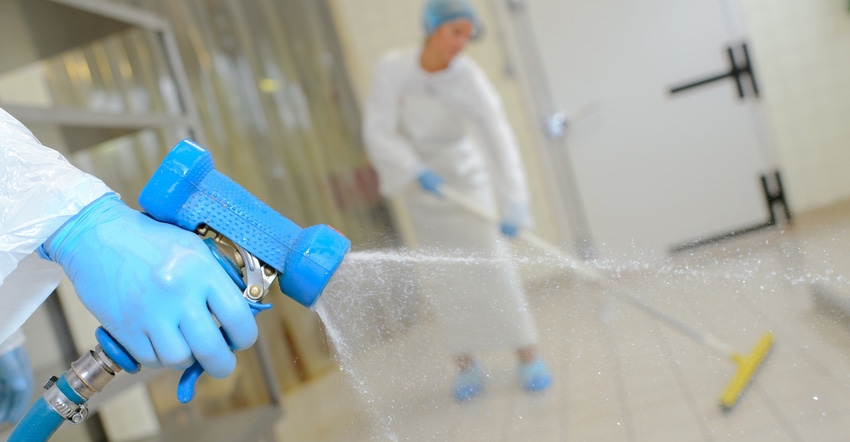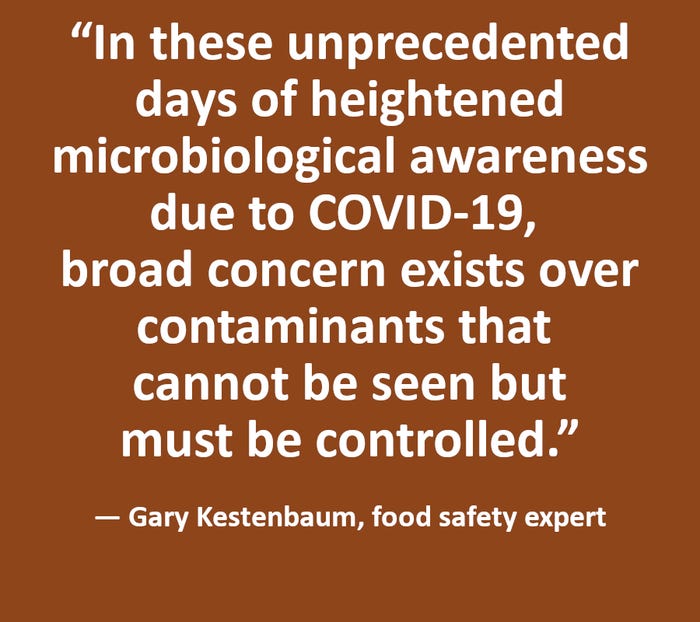Food safety expert lists processes and resources for packaging line cleaning guidelines and laws, even as new procedures and solutions specific to controlling the COVID-19 virus emerge.
July 29, 2020

During the COVID-19 pandemic, much has been written about methods used to clean, sanitize, and disinfect surfaces, equipment and people.
Since COVID-19 has cost so many lives and is so virulent and insidious, official and expert resources are being pushed to provide ongoing answers and information in the form of guidance, governance, and best practices. Even though coronaviruses are not new, mutations can be unique and, therefore, stubbornly different based on sequences or genomes. So, guidances are based on “best available” knowledge to date, which may be limited, incomplete, or, at worst, inaccurate.
Thus, safety and sanitation experts have their hands full determining which substances or methods to use to execute functional kills of coronavirus that are complete and effective. It will be a daunting task for independent labs to take and analyze “clean” samples at production facilities and validate COVID-19 kill effectiveness. Until methods for killing and disrupting the spread of the COVID-19 virus become tested and mathematically validated, experts must depend upon best practices known to date and make sensible, conservative additions to existing Sanitation Standard Operating Procedures (SSOPs) based on “best available” information.
Let’s look at what we already know.
Defining cleaning terms.
The concepts of applying consistent, documented, defined-interval, and situational “cleansing” and disinfection protocols to materials and equipment used to produce and distribute comestibles are intended to meet or exceed regulatory targets, requirements and safety scheme (program) objectives, as per current guidance.
Regardless of the final objective, which should be product and situation-specific as defined by regulations, laws and best practices, the purpose for requiring, evaluating, and developing sanitation procedures is simply to assess and understand the risks for physical, chemical, and microbiological contamination — and control or eliminate them.
Terms such as cleaning, cleansing, sanitation, sanitization and sanitizing, and sterilization have likely never been more relevant or discussed in world households. Nothing like a worldwide catastrophe to popularize technical terminology and generate awareness. The general public may have misunderstandings about the definitions of these terms and technologies, so let’s start by defining and explaining same as they relate to packaging and packaging equipment used in the processing, manufacture, and distribution of comestible products.
• “Cleaning and cleansing” refer to practices intended to remove visible contaminants, such as unwanted, incidental, or unintentionally occurring matter, residues, allergens, and other contaminants from equipment, utensils, and work surfaces.
• “Sanitation” can have different meanings based on context. The World Health Organization (WHO) defines sanitation broadly as the processes or conditions necessary to safely manage (human or animal) waste for the purpose of providing water and environments free from infectious diseases caused by microbiological contaminants. Alternately, sanitation subject matter experts (SMEs) tasked to control contamination of comestibles define “sanitation” as designed, targeted, and validated written plans composed of processes and procedures intended to maintain equipment and environs in a sanitary condition for processing, packaging, and storing foods. It is a step-by-step description of cleaning and sanitizing procedures developed to cleanse and decontaminate areas and surfaces which, if not controlled, would represent hazards to consumers.
•“Sanitization” as defined in the US Food Code denotes the use of one or more suitable and approved control mechanisms (typically heat or chemicals) on cleaned and designated contact surfaces, which yield at least a 5 log (equivalent to a) 99.999% reduction of representative disease microorganisms of public health importance when properly evaluated for efficacy (validated).
In addition to visible surfaces, sanitization may also refer to ambient or process air, water, and steam — all of which are required to achieve some level of physical, chemical, and microbiological purity based on applications and objectives of packaging and supporting edibles. As an example, “sanitizing” of air is not the process of freshening it. Freshening is a qualitative sensory process. Sanitation is a qualitative and quantitative verification of targeted purity.
• “Sterilization” differs from sanitizing, in that it utilizes approved methods that require a verified removal of all microorganisms from a surface or substance. The context of sterilizing is typically related to medical applications rather than areas that handle comestibles. Notable exceptions in the food industry include materials and surfaces of aseptic or ultra-clean packaging and equipment or circumstances where specific micro qualities and quantities must be met, such as labeled as “sterile” single-use packaging or personal protective equipment (PPEs).
Listing expert resources.
A number of resources provide written guidance for virtually any comestible product circumstance, including the packaging of comestibles and the materials and equipment used.
Expert reference resources for control of contaminants include:
• United States Code of Federal Regulations
• US Food and Drug Administration (FDA) Bacteriological Analytical Manual (BAM)
• US Department of Agriculture (USDA) Food Safety and Inspection Services (FSIS) compliance documents
• USDA Agricultural Marketing Services (AMS) guidance documents
• United States Environmental Protection Agency (EPA)
• United Nations WHO Codex Alimentarius and subject-related compendia, including the United States Pharmacopeia and Food Chemicals Codex
• Flavor and Extract Manufacturers Association (FEMA) Generally Recognized as Safe (GRAS)
• American Public Health Association (APHA) Compendium of Methods for the Microbiological Examination of Foods, et al
• And globally recognized private safety certification organizations..
As mentioned earlier, the objectives for “packaging” are fundamentally the same as the products they are intended to contain, with some specific measurable exceptions such as water activity (aw) and acidity or alkalinity (pH). The fundamental objective required to deliver safe product necessitates that product and package be free of contaminants, violative materials, or adulteration. By relationship, the support mechanisms for comestibles — their packaging, storage, and transportation — must also meet similar requirements. Think about “eating clean food with dirty utensils.”
Setting up the process.
For any facility to create an effective contamination-free operating environment, the designated subject matter experts tasked with sanitation must analyze risks from literally the ground up, beginning with the exterior air, ground, and water quality, all the way through transportation and storage.
As with the comestible, the packaging materials, equipment, and support mechanisms must be designed and handled to provide the requirements, targets, extent, and limits of composition and purity as defined by the experts creating specifications and instructions using the reference information in the resources listed above.
In a proper application of (edibles safety) protocols, qualified experts (quality, microbiology, sanitary design, sanitation chemists and engineers) will collaborate to document the information used to create Sanitation Standard Operating Procedures (SSOPs), and Hazard Analysis and Critical Control Point (HACCP) or Hazard Analysis and Risk-Based Preventive Controls (HARPC) plans and related protocols. These protocols are intended to create environments, conditions, and handling conditions that are verified to deliver and maintain safe packaging and conditions designed as suitable for each individual product, subline, or component.
The process begins with creating a suitable base environment, including the facility and surrounding areas. For example, if the next-door neighbor up-wind of the plant produces, bulk-stores, or conveys materials determined to be hazardous or contaminating to edibles, the imperiled company must mitigate the risk of air or ground borne water contamination. It must also vet all physical processes and/or chemical applications. Chemicals used in comestible sanitation or sanitization must be scheduled, regulatory approved, and meet assigned quality standards as per law and approved compendia.
Next, the packaging materials and handling will be specified. Technical experts will evaluate conditions and specify quality standards for food-contact packaging components. As with incoming food ingredients and in-process equipment and accessories, food safety and quality overseers need to presume that incoming packaging components need decontamination until the implementation of effective prerequisite or hazard controls prove otherwise.
Vetting the process and method(s).
When equipment and support services are engineered and evaluated, be they new or used, they need to tested and vetted for post-sanitation quality. Same with packaging materials. After the sanitizing rinse, the UV treatment, the ozone, the sterilization, the chemical wash, the addition of ultra-hot product, the retort, the H2O2 bath, or other valid process — the process and products must be able to withstand and pass a scientifically identified and statistically validated “micro challenge.” The quantitative values and qualitative results will differ from product to product, but the results must meet sanitation specifications. Service materials must test clean as well: Steam, air, water, storage, transport must all test acceptable vs. specific cleanliness quality.
The list of methods and chemical compounds approved for use and determined to be effective microbial control agents are too numerous to name and describe, as they are subject to change. In these unprecedented days of heightened microbiological awareness due to COVID-19. , broad concern exists over contaminants that cannot be seen, but must be controlled.

Experts may refer to the EPA website (List N: Disinfectants for Use Against SARS-CoV-2 (COVID-19)), the FDA website (www.fda.gov/food/food-safety-during-emergencies/food-safety-and-coronavirus-disease-2019-covid-19), the USDA website (www.usda.gov/coronavirus) and the web sites of qualified, certified commercial organizations that provide guidance and services relating to sanitation, disinfection, and cleansing. Be aware, though, that published data may be based on “best information to date with methodology” and may not reference all conditions and circumstances.
Sanitation engineers and quality control management may benefit from any number of methods to deliver sanitizing and disinfection media, chemical and physical. Time-honored procedures include controlled-condition baths, washes, sprayers, injectors, pressure systems, pumps, applicators, scrubbers, temperature controls, and concentrators. More targeted methods for application include electromagnetic radiation (such as UV light), ultrasonic foggers, electrostatic dispensing applicators, and pressurized blasting (dry ice/CO2, for example) to name a few more recent methodologies.
SMEs tasked with insuring safety are charged with the unenviable responsibility of having to engage in a HACCP or HARPC type of risk analysis. They must familiarize themselves with the challenges, nuances of the facility and its infrastructure, the risks of contamination, cross-contamination, and infection of materials, equipment, people, and the ways that they can all enter the supply and manufacturing chain. As if that learning were not a challenging enough exercise, they must then build the process, test the process, validate the process (hopefully using independently-performed micro challenges in high-risk or required processes) and be prepared with a “plan B” in the event of a positive test or breach in the sanitation process.
Sanitation experts and microbiologists are aware of the risks of contaminants being brought into a facility during standard day-to-day activities. Ambient airflow from outside or room to room can facilitate contamination, as well as foot traffic. Other potential sources of contamination include packaging of anything and everything entering the facility (which is a daunting concept once you begin to create a list), as well as from internal storage, trash receptacles and cleaning implements, new parts and equipment, employees, transient visitors, office workers, and so forth.
As if that were not challenging enough, safety and quality managers have to ensure that materials and application equipment/methods used to eliminate or control the host of contaminants “do no harm.” Excess concentrations of sanitizing chemicals, unwanted employee exposure to sanitizing and disinfecting media, and unanticipated contamination of comestibles, packaging, and process equipment with sanitizing and disinfecting chemicals have all occurred in the past in food and/or food packaging plants, resulting in embargo and recall.
About the Author(s)
You May Also Like




